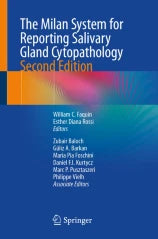The Milan System for Reporting Salivary Gland Cytopathology
- Unit price
- / per
-
Author:William Facquin / Esther Diana Rossi / Zubair Baloch
-
ISBN:9783031266614
-
Publication Date:January 2023
-
Edition:2
-
Pages:
-
Binding:Paperback
-
Publisher:Palgrave-Springer
-
Country of Publication:Switzerland


A Back Order button means that we don’t have the book in stock at our store. It may already be on order – or we can order it for you from a publisher or distributor at no additional cost.
As we source items from around the globe, a back-order can take anywhere from 5 days to several weeks to arrive, depending on the title.
To check how long this might take, you’re welcome to contact us and we can provide an ETA or any other information you need. We recommend checking the timeframe before committing to an online order.
The Milan System for Reporting Salivary Gland Cytopathology
- Unit price
- / per
-
Author:William Facquin / Esther Diana Rossi / Zubair Baloch
-
ISBN:9783031266614
-
Publication Date:January 2023
-
Edition:2
-
Pages:
-
Binding:Paperback
-
Publisher:Palgrave-Springer
-
Country of Publication:Switzerland
Description
The Second Edition of The Milan System for Reporting Salivary Gland Cytopathology, like the First Edition, represents a collaborative effort by a multidisciplinary group of cytopathologists, surgical pathologists, molecular pathologists, radiologists, and head and neck surgeons. This international group shares the goal of creating a practical and uniform reporting system for salivary gland fine needle aspiration (FNA). This book is organized into six general diagnostic categories: “Non-Diagnostic,” “Non-Neoplastic,” “Atypia of Undetermined Significance (AUS),” “Neoplasm: Benign,” “Neoplasm: Salivary Gland Neoplasm of Uncertain Malignant Potential (SUMP),” “Suspicious for Malignancy,” and “Malignant.” It includes definitions, morphologic criteria, and explanations for each of the diagnostic categories. Specific chapters are dedicated to the application of the latest available ancillary studies, radiologic features of salivary gland lesions, clinical management, and histological considerations including updates from the most recent 5th Edition WHO blue book.
Adding product to your cart
You may also like
A Back Order button means that we don’t have the book in stock at our store. It may already be on order – or we can order it for you from a publisher or distributor at no additional cost.
As we source items from around the globe, a back-order can take anywhere from 5 days to several weeks to arrive, depending on the title.
To check how long this might take, you’re welcome to contact us and we can provide an ETA or any other information you need. We recommend checking the timeframe before committing to an online order.
You may also like
You may also like
-
The Second Edition of The Milan System for Reporting Salivary Gland Cytopathology, like the First Edition, represents a collaborative effort by a multidisciplinary group of cytopathologists, surgical pathologists, molecular pathologists, radiologists, and head and neck surgeons. This international group shares the goal of creating a practical and uniform reporting system for salivary gland fine needle aspiration (FNA). This book is organized into six general diagnostic categories: “Non-Diagnostic,” “Non-Neoplastic,” “Atypia of Undetermined Significance (AUS),” “Neoplasm: Benign,” “Neoplasm: Salivary Gland Neoplasm of Uncertain Malignant Potential (SUMP),” “Suspicious for Malignancy,” and “Malignant.” It includes definitions, morphologic criteria, and explanations for each of the diagnostic categories. Specific chapters are dedicated to the application of the latest available ancillary studies, radiologic features of salivary gland lesions, clinical management, and histological considerations including updates from the most recent 5th Edition WHO blue book.
-
-
Author: William Facquin / Esther Diana Rossi / Zubair BalochISBN: 9783031266614Publication Date: January 2023Edition: 2Pages:Binding: PaperbackPublisher: Palgrave-SpringerCountry of Publication: Switzerland
The Second Edition of The Milan System for Reporting Salivary Gland Cytopathology, like the First Edition, represents a collaborative effort by a multidisciplinary group of cytopathologists, surgical pathologists, molecular pathologists, radiologists, and head and neck surgeons. This international group shares the goal of creating a practical and uniform reporting system for salivary gland fine needle aspiration (FNA). This book is organized into six general diagnostic categories: “Non-Diagnostic,” “Non-Neoplastic,” “Atypia of Undetermined Significance (AUS),” “Neoplasm: Benign,” “Neoplasm: Salivary Gland Neoplasm of Uncertain Malignant Potential (SUMP),” “Suspicious for Malignancy,” and “Malignant.” It includes definitions, morphologic criteria, and explanations for each of the diagnostic categories. Specific chapters are dedicated to the application of the latest available ancillary studies, radiologic features of salivary gland lesions, clinical management, and histological considerations including updates from the most recent 5th Edition WHO blue book.
-
Author: William Facquin / Esther Diana Rossi / Zubair BalochISBN: 9783031266614Publication Date: January 2023Edition: 2Pages:Binding: PaperbackPublisher: Palgrave-SpringerCountry of Publication: Switzerland
-



